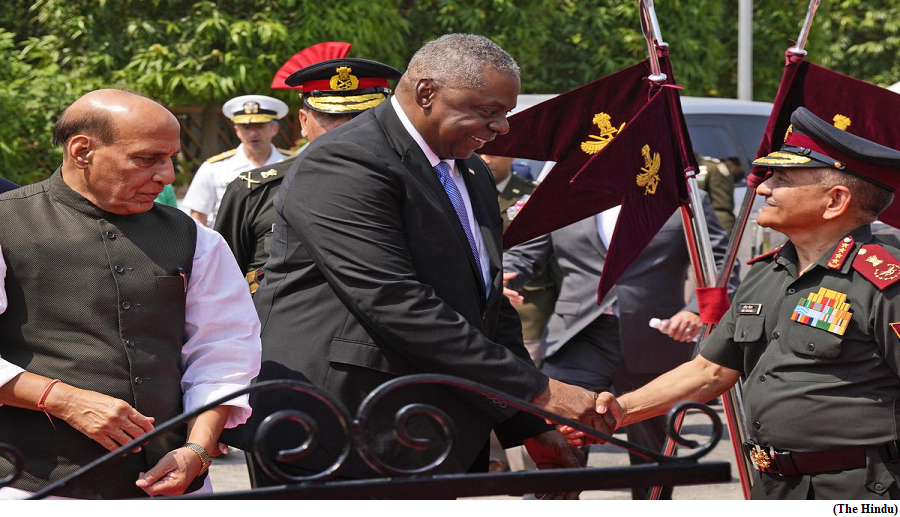Jumpstarting the next phase of U.S. India defence ties (GS Paper 2, International Relation)

Context:
- The recent visit of the US Secretary of Defence to India to reinforce the major defence partnership and advance cooperation in critical domains.
Details:
- Over the last few years, there has been incredible momentum in U.S.-India ties, driven primarily by their defence relationship.
- His visit secured an agreement on a road map for defence industrial cooperation, announced as part of the U.S.-India initiative on Critical and Emerging Technology (iCET) agreement (announced in May 2022). The road map envisages boosting defence manufacturing in India through greater technological cooperation.
Objective:
- The visit’s objective had two important legs: technological innovation and growing military cooperation. One of the most important steps taken during the visit was towards strengthening the bilateral defence relationship by creating a road map to promote collaboration in the defence industry.
- The road map aims to expedite crucial co-development and co-production initiatives, fostering stronger connections between the defence sectors of the two countries.
Indus-X:
- There was the launch of a new initiative, Indus-X, which is to provide a new impetus to the defence innovation engagement between the two countries.
- This builds on the U.S.-India bilateral Space Situational Awareness arrangement signed in 2022, which promises to enhance information-sharing and cooperation in the space sector.
- Furthermore, new areas in defence space exchanges have been identified based on the cooperation between the U.S. Space Command and India’s Defence Space Agency.
MDP Status:
- India’s ‘Major Defence Partner’ (MDP) status along with the four foundational agreements signed with the U.S. now allow for the sharing of technology and more frequent cooperation.
- These have not only allowed the sharing of sensitive technologies without India having to become an ally but have also proved to be effective mechanisms to prevent backsliding due to procedural difficulties or structural differences.
Indo-Pacific factor:
- During the 2+2 Ministerial Dialogue in April 2022, the U.S. Defence Secretary referred to the U.S.-India defence partnership as the cornerstone of their engagement in the Indo-Pacific.
- He outlined broad aspects in the Indo-Pacific including
- coercive actions by China;
- the aggressive actions of Russia towards Ukraine aimed at forcibly redrawing borders and undermining national sovereignty;
- transnational issues such as terrorism and climate change.
- The combined threat assessments by India and the U.S. in the region point to China as a common and most conspicuous challenge.
China’s Military Power:
- As stated in China’s Military Power Report 2022 brought out by the U.S., the People’s Liberation Army Navy is the world’s largest navy by number of ships.
- With the Indo-Pacific region getting more contested, it is estimated that the subsurface presence of China is likely to increase in the Indian and Pacific Oceans.
India’s defence modernisation:
- Beyond the Indo-Pacific, a strong rationale for projecting broader industrial cooperation between Indian and U.S. companies in the defence sector is the existing scale of American investments in India.
- Behind this is an almost declaratory support by the U.S. government exhorting its companies to support India’s defence modernisation.
- In the long run, this could lead to at least three dominant trends under the umbrella of U.S.-India defence cooperation:
- nurturing and growth of an ecosystem of joint ventures between companies;
- the U.S. incrementally gaining a larger share in the Indian defence manufacturing, and
- both sides ironing out existing impediments in co-development and co-production.
- American companies led by Boeing, Lockheed Martin, BAE Systems, Honeywell Aerospace, Raytheon, Textron and others partner across a range of manufacturing activities related to the defence sector with Indian companies, most prominently with Hindustan Aeronautics Limited and the Tata group.
- These are likely to be supplemented by linking defence start-ups from both countries through an ‘innovation bridge’ that was announced in the iCET agreement.
Way Forward:
- The visit of the U.S. Defence Secretary has prepared the ground for the official state visit of Prime Minister Narendra Modi to the U.S., which could see a few big ticket announcements, especially in the area of defence cooperation.
- The sky, it seems, is the limit in the emerging defence partnership between two of the world’s leading democracies.


